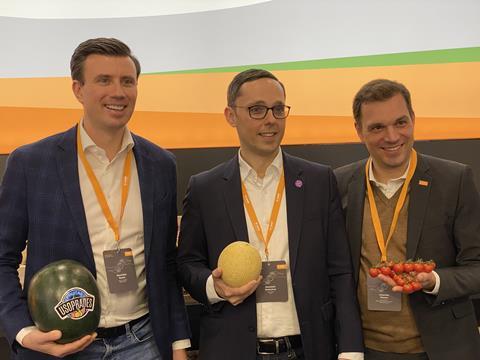The ‘Xarvio Field Manager for Fruits & Veggies’ will first be made available to grape growers in 2025, following BASF’s acquisition of Italian agritech firm Horta in 2022

BASF Digital Farming has announced the 2025 launch of its Xarvio Field Manager for Fruits & Veggies.
The precision farming tool offers growers tailored, field-specific advice on how to grow their crops most efficiently and effectively based on a wide range of data.
The solution already exists for other crop sectors, such as soybeans, corn, cotton, wheat, barley, canola, sugar cane, sugar beet, potatoes and rice. And now BASF has launched the service for fresh produce too.
The multinational is kicking off with table and wine grapes in 2025, targeting the markets of France, Spain, Italy and Turkey.
After that, the platform’s crop offering will be expanded to support growers of tomatoes and potatoes. Additional fruits and vegetables will follow in years to come.
The platform will initially be used by growers in Southern Europe, before being rolled out in other production regions.
The launch of Xarvio for fresh produce growers follows BASF’s acquisition of the Italian agritech business Horta in 2022.
Horta has been around for more than 25 years and uses scientific models to advise growers on how to produce fruits and vegetables in a way that optimises productivity, environmental sustainability, and food safety.
The two businesses are now “fully integrated”, according to the vice-president of BASF Digital Farming, Konstantin Kretschun.
Commenting on BASF’s experience in other agricultural sectors over the past 10 years, Kretschun said: “Our digital agronomic platform uses cutting-edge technology. You have satellite data, drone data, machine connectivity. But the thing that differentiates us is what we call ‘agronomic intelligence’.
“Over the course of the last 10 years we have acquired four companies with the unique capability to develop algorithms that accurately predict the growth of a plant, the need of irrigation, diseases, weeds, and the insect population.
“There are certain inputs the farmer needs to use, so what we do is monitor and predict when, what, how much, and where in the field to spray.”
In tomatoes, the focus will be on delivering water efficiency, product quality, and a lower carbon footprint, Kretschun revealed.
Indeed, a Xarvio trial has already helped one well-known Italian tomato grower to reduce its water use by 40 per cent and increase the Brix of one of its varieties by 25 per cent.
Kretschun acknowledged that implementing the platform could prove challenging given the aging population of the fresh produce sector in many countries, but he stressed that demand for precision farming solutions is high given the intensifying labour, climate and environmental pressures on growers around the world.
Johannes Weimer of BASF Agricultural Solutions emphasised the importance of combining BASF’s digital offer with suitable varieties and crop protection products. These are the other main pillars of the BASF business, whose slogan is ‘connecting for greater value’.
“It’s not only about the digital solution, but also using the right seeds, specific crop protection products, and having a very targeted spraying programme tailored to the specific needs of the grower and the genetics,” he said.
“That’s how you can drive value. We want to help growers unleash their full potential by offering them a complete package.”
When it comes to pests and diseases, Maximilian Becker, senior vice president of BASF Nunhems, highlighted apple scab, alternaria (in potatoes), ToBRFV (in tomatoes), and downy mildew (in grapes and leafy vegetables) as some of the most problematic diseases threatening fresh produce growers at the moment.
BASF’s customer marketing specialist Naz Ahmed told Fruitnet “nobody is talking about any lettuce varieties without downy mildew resistance at the moment” and revealed that two new resistant iceberg varieties are currently being trialled in Northwestern Europe.
He said downy mildew is becoming more noticeable as a problem because growers are generally producing a smaller range of lettuce varieties. Furthermore, extreme heat and humidity in growing countries such as Spain has increased the instance of the disease.



